Impact of farming models on the reproductive performance and egg quality of Vietnamese local chicken breeds: Ho and Dong Tao
The study was conducted from October 2016 to December 2017 at
the Experimental Farm, Faculty of Animal Science, Vietnam
National University of Agriculture, with the aim to evaluate the
interaction between farming model types and reproductive
performance of Ho and Dong Tao chickens. The two farming model
types used in this research were (1) the traditional type – backyard
and (2) the ameliorate type – battery cage. Data were collected from
61 Ho hens and 61 Dong Tao hens continuously during 52 laying
weeks. The total number of eggs laid by hens raised in battery cages
averaged 88.47 eggs (for Ho hens) and 94.91 eggs (for Dong Tao
hens), 35-38% higher than the number of eggs laid by hens raised in
a traditional model. The FCR index per 10 eggs laid in battery cages
was significantly lower than that in the back-yard model (P<>
In both the Ho and Dong Tao breeds, the rate between the number of
embryonated eggs by number of incubated eggs recorded in the
ameliorate model was higher than that recorded in the traditional
model (P< 0.01="" for="" ho="" chickens,="">< 0.001="" for="" dong="" tao).="" the="">
of eggs produced by hens raised in battery cages was higher than eggs
laid by free-range hens for both Ho and Dong Tao chickens (P<>
As such, the reproductive performances and egg quality of both Ho
and Dong Tao breeds were apparently improved when chickens were
raised in battery cages.
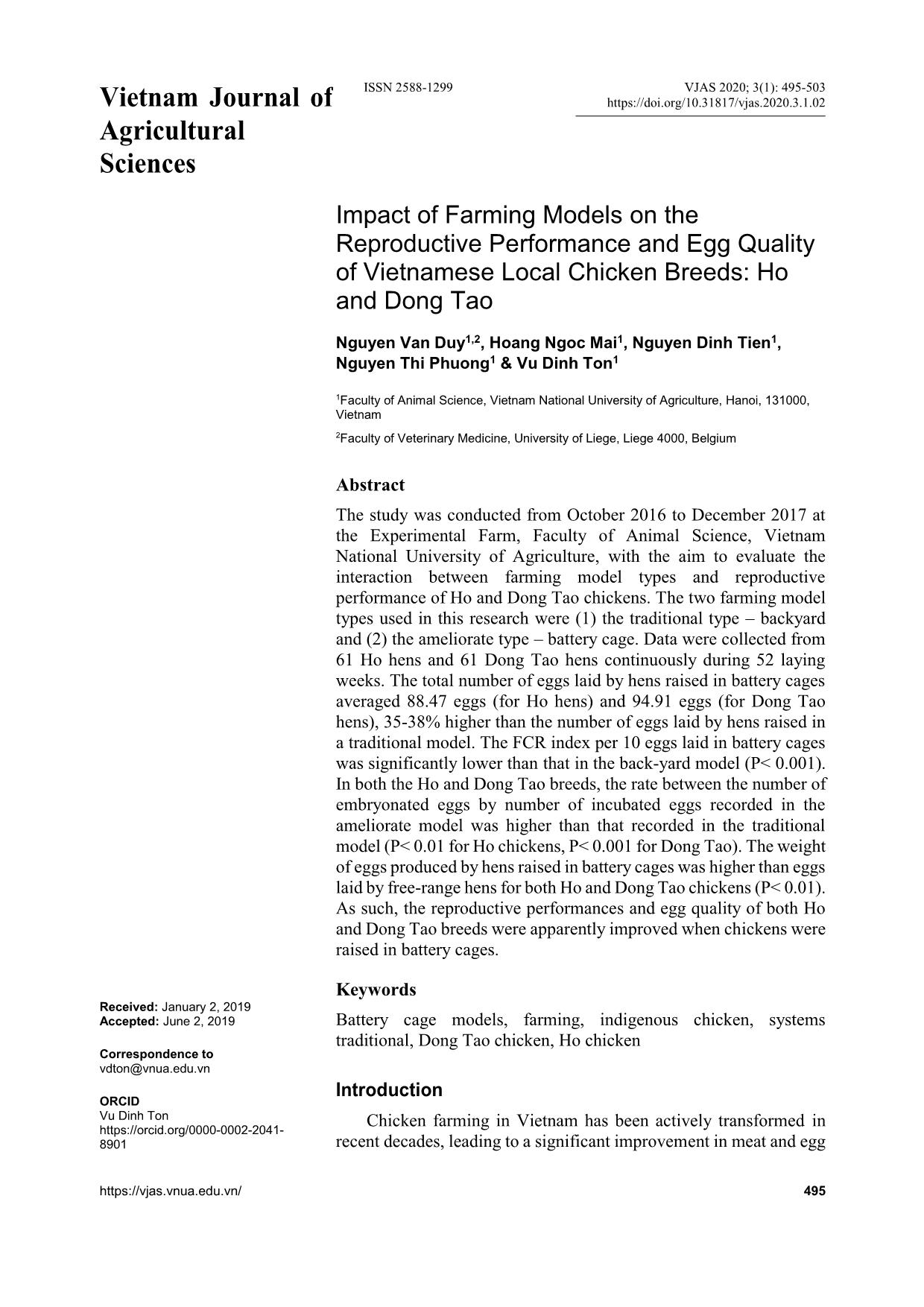
Trang 1
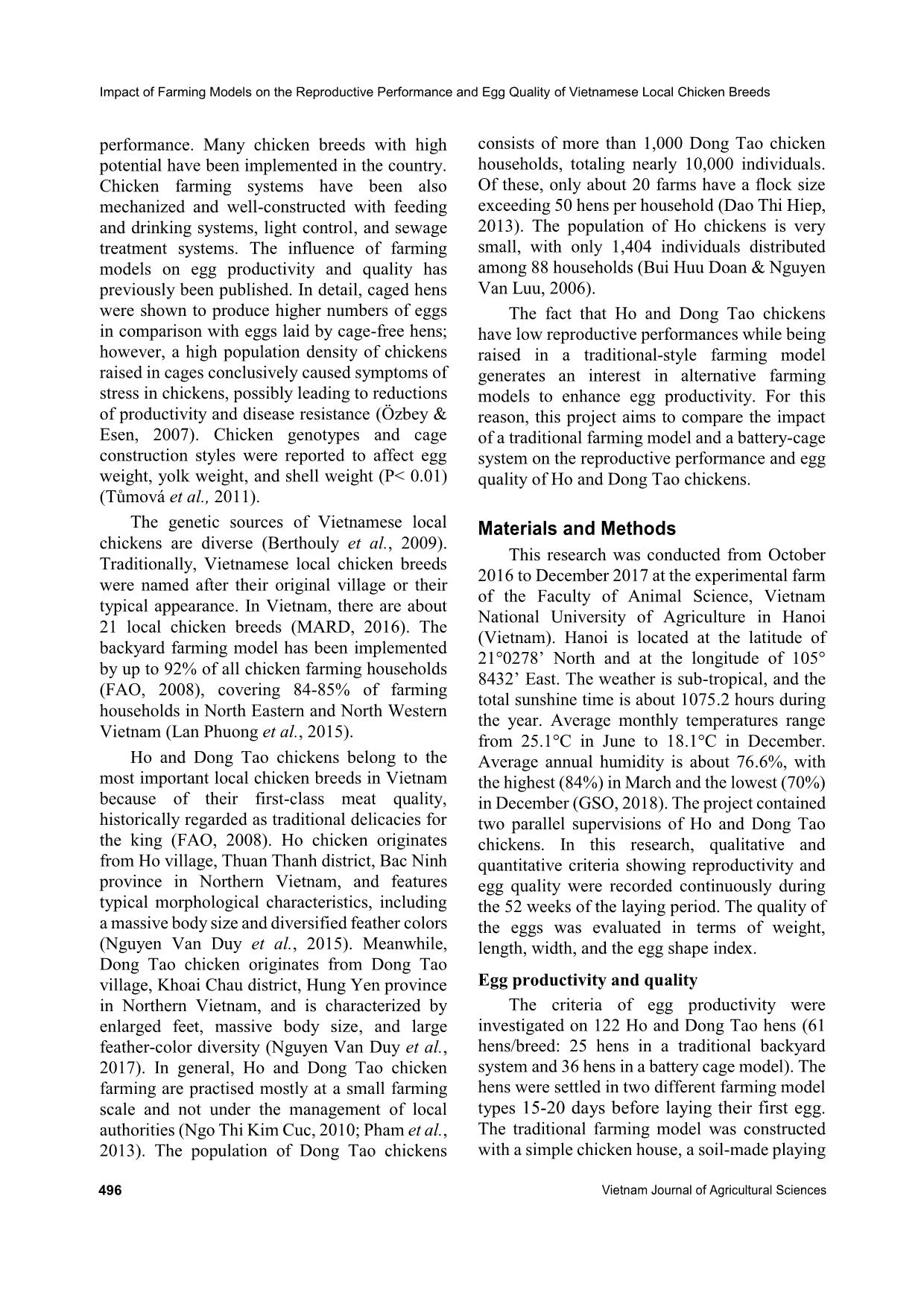
Trang 2
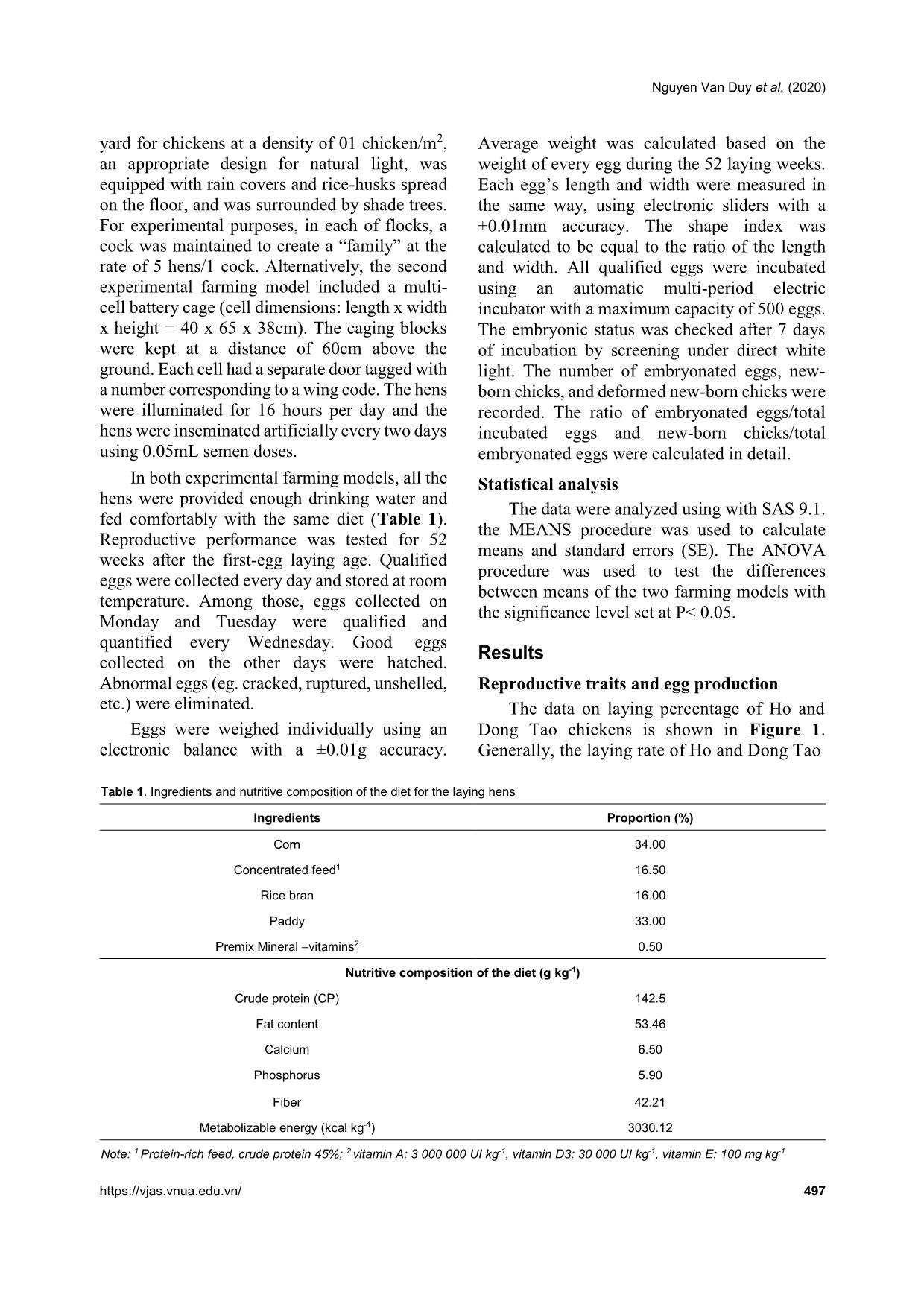
Trang 3
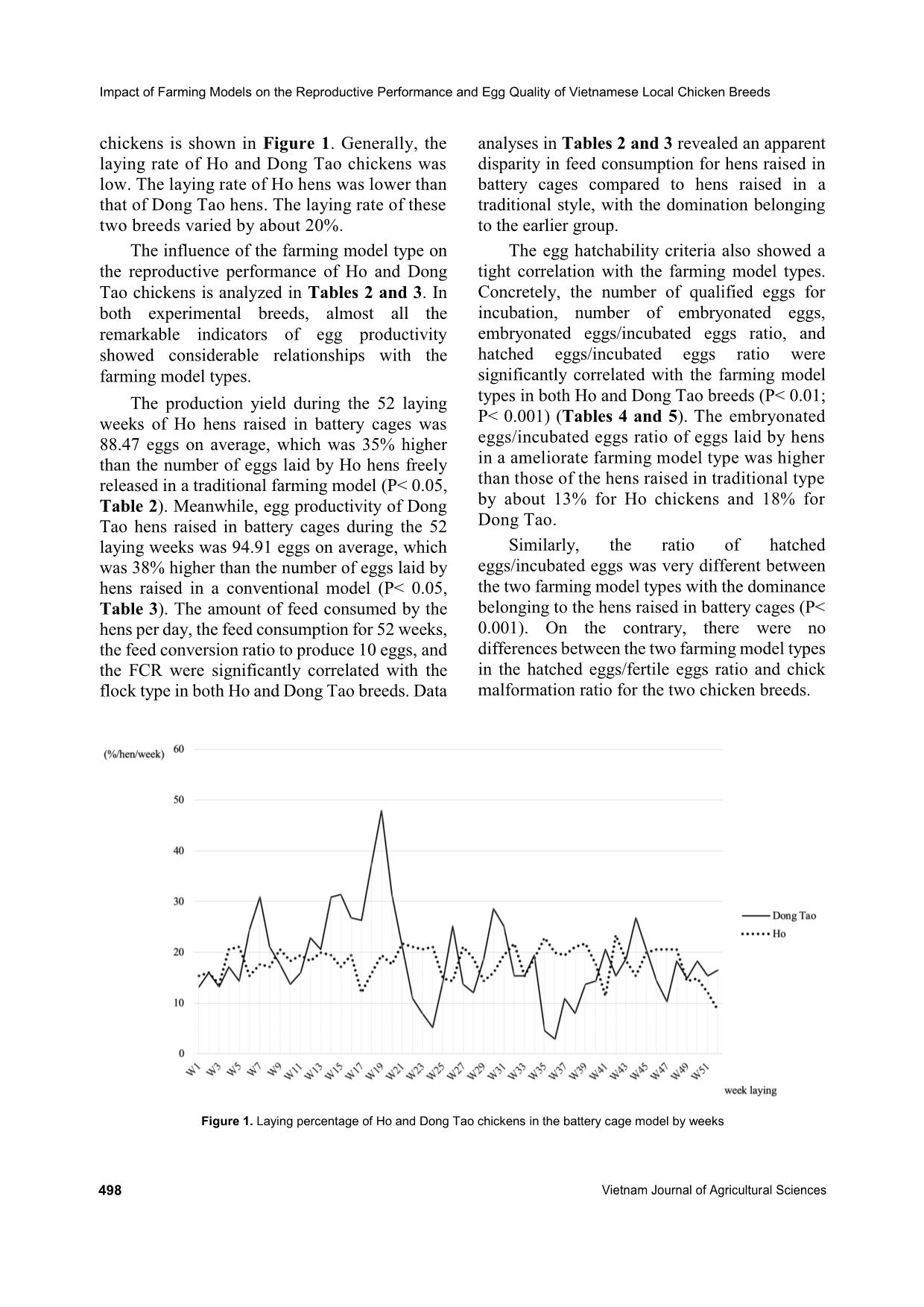
Trang 4
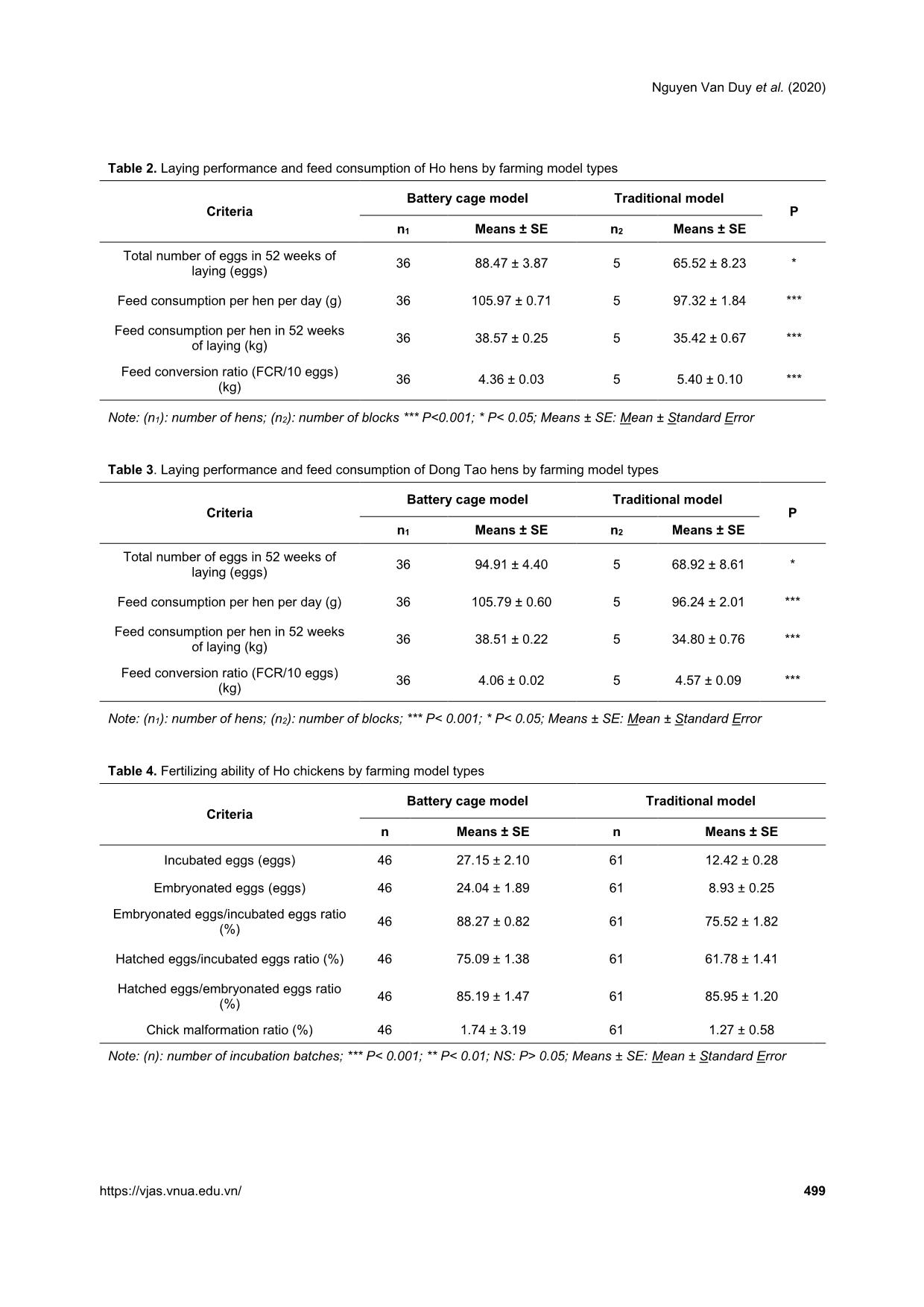
Trang 5
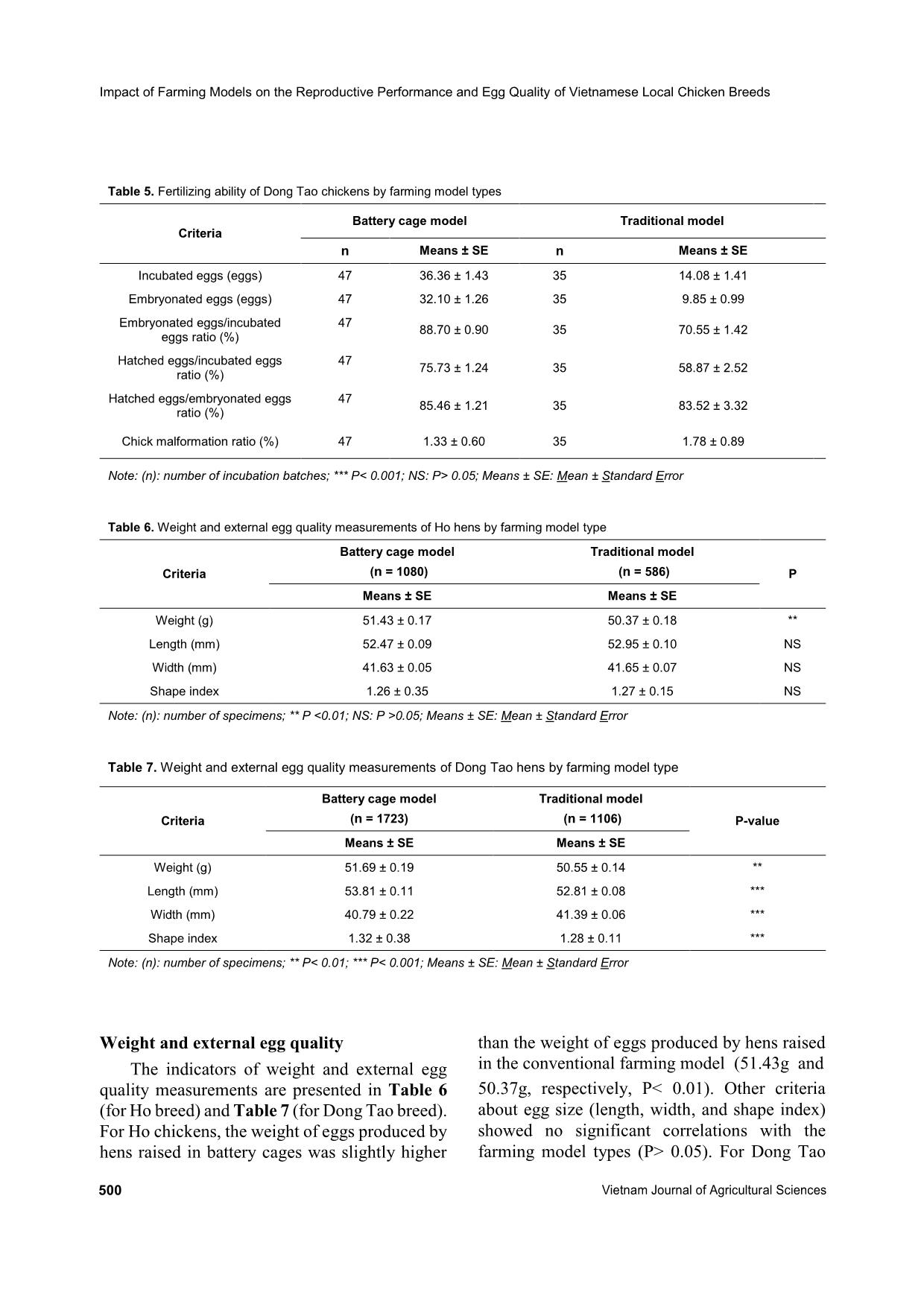
Trang 6
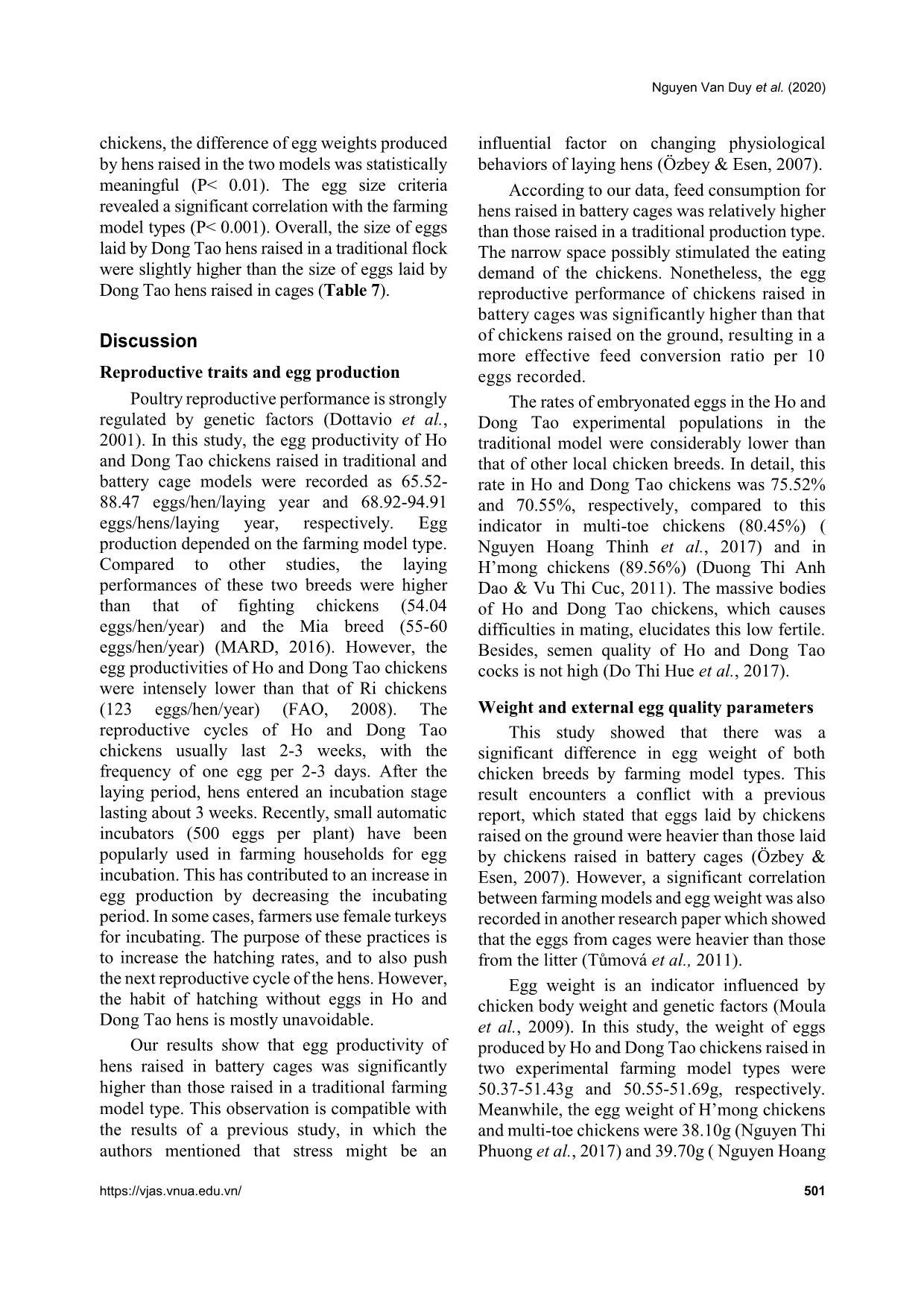
Trang 7
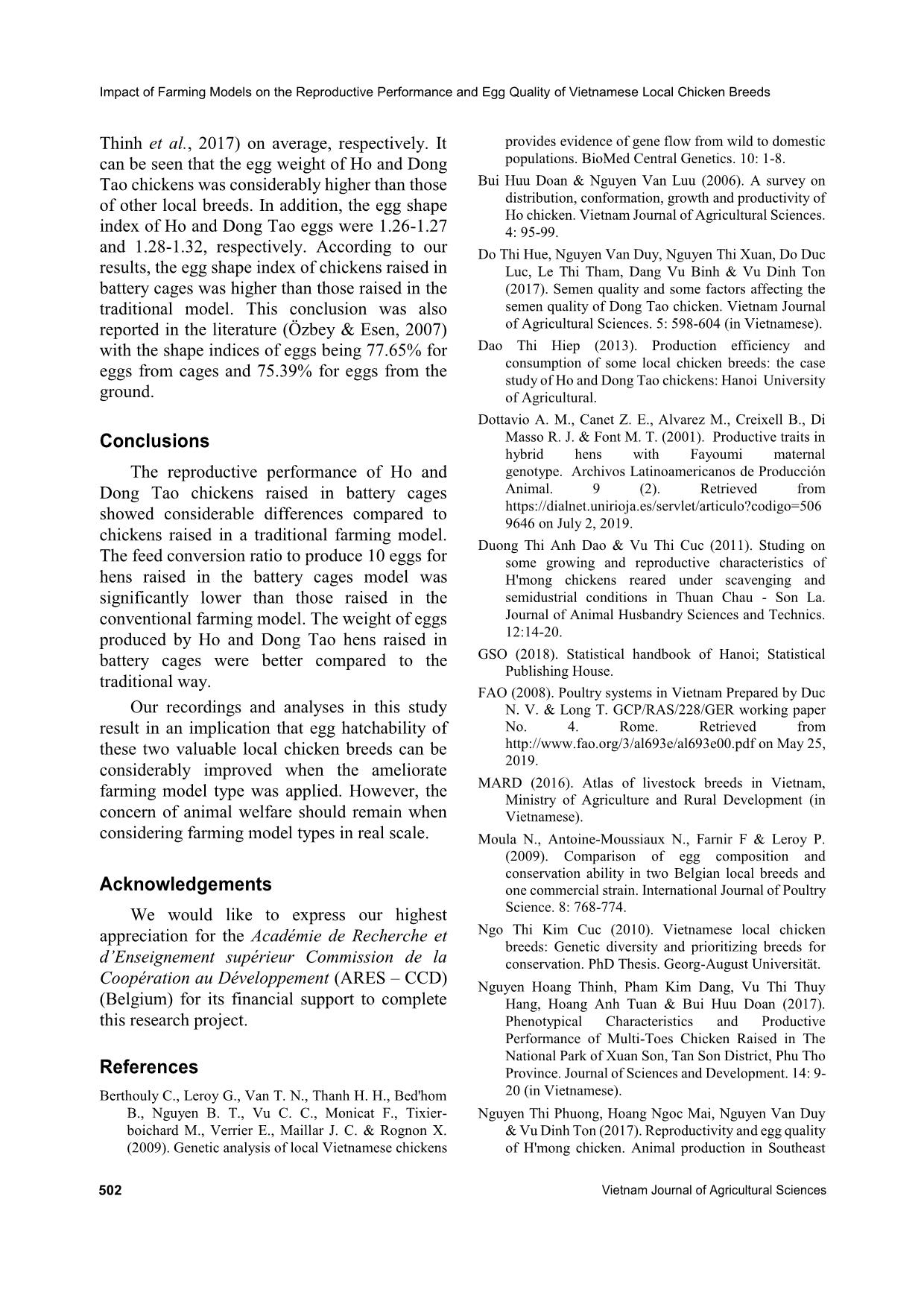
Trang 8
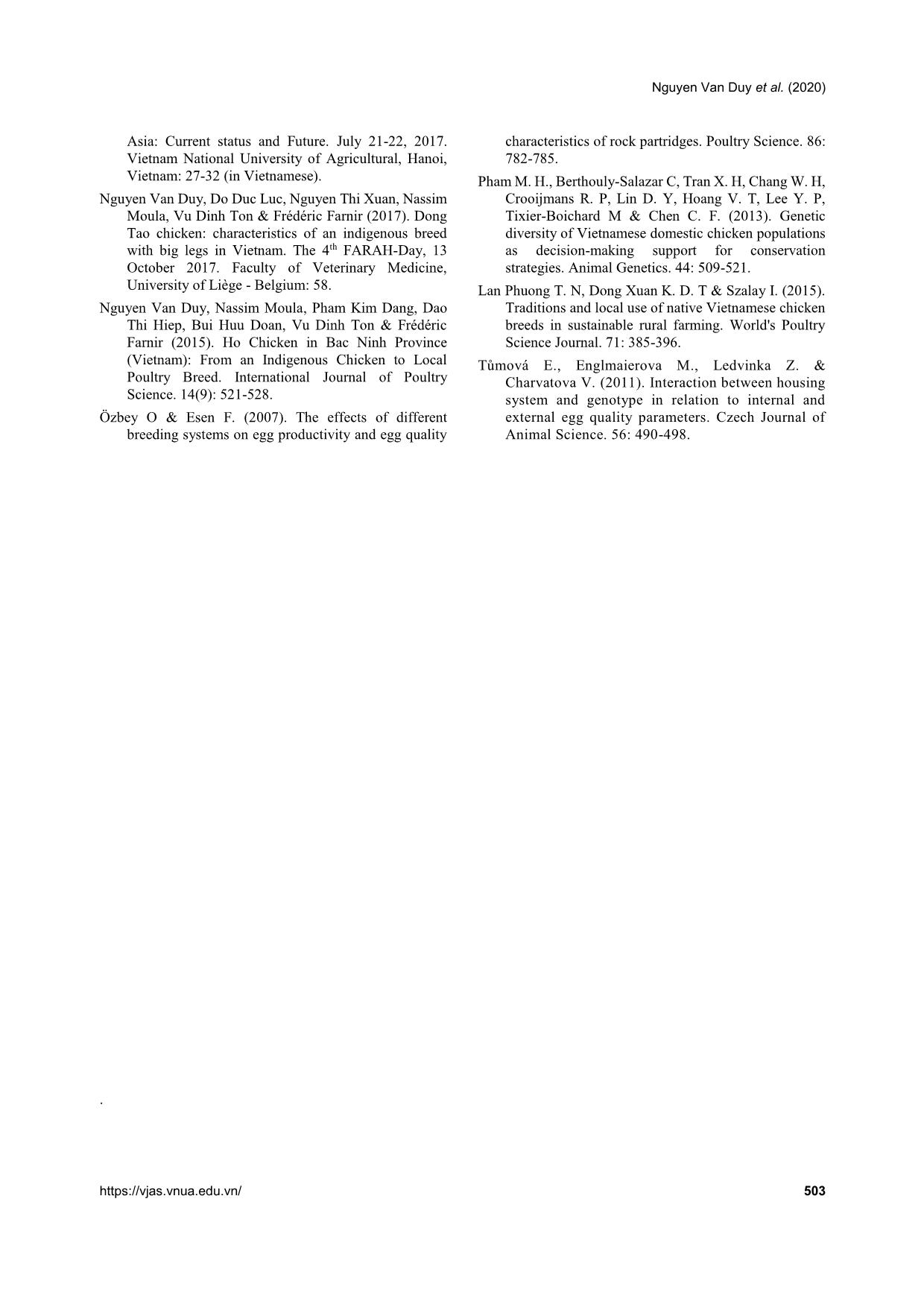
Trang 9
Tóm tắt nội dung tài liệu: Impact of farming models on the reproductive performance and egg quality of Vietnamese local chicken breeds: Ho and Dong Tao
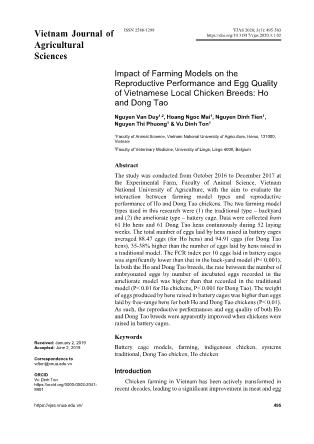
ng performance and feed consumption of Ho hens by farming model types Criteria Battery cage model Traditional model P n1 Means ± SE n2 Means ± SE Total number of eggs in 52 weeks of laying (eggs) 36 88.47 ± 3.87 5 65.52 ± 8.23 * Feed consumption per hen per day (g) 36 105.97 ± 0.71 5 97.32 ± 1.84 *** Feed consumption per hen in 52 weeks of laying (kg) 36 38.57 ± 0.25 5 35.42 ± 0.67 *** Feed conversion ratio (FCR/10 eggs) (kg) 36 4.36 ± 0.03 5 5.40 ± 0.10 *** Note: (n1): number of hens; (n2): number of blocks *** P<0.001; * P< 0.05; Means ± SE: Mean ± Standard Error Table 3. Laying performance and feed consumption of Dong Tao hens by farming model types Criteria Battery cage model Traditional model P n1 Means ± SE n2 Means ± SE Total number of eggs in 52 weeks of laying (eggs) 36 94.91 ± 4.40 5 68.92 ± 8.61 * Feed consumption per hen per day (g) 36 105.79 ± 0.60 5 96.24 ± 2.01 *** Feed consumption per hen in 52 weeks of laying (kg) 36 38.51 ± 0.22 5 34.80 ± 0.76 *** Feed conversion ratio (FCR/10 eggs) (kg) 36 4.06 ± 0.02 5 4.57 ± 0.09 *** Note: (n1): number of hens; (n2): number of blocks; *** P< 0.001; * P< 0.05; Means ± SE: Mean ± Standard Error Table 4. Fertilizing ability of Ho chickens by farming model types Criteria Battery cage model Traditional model n Means ± SE n Means ± SE Incubated eggs (eggs) 46 27.15 ± 2.10 61 12.42 ± 0.28 Embryonated eggs (eggs) 46 24.04 ± 1.89 61 8.93 ± 0.25 Embryonated eggs/incubated eggs ratio (%) 46 88.27 ± 0.82 61 75.52 ± 1.82 Hatched eggs/incubated eggs ratio (%) 46 75.09 ± 1.38 61 61.78 ± 1.41 Hatched eggs/embryonated eggs ratio (%) 46 85.19 ± 1.47 61 85.95 ± 1.20 Chick malformation ratio (%) 46 1.74 ± 3.19 61 1.27 ± 0.58 Note: (n): number of incubation batches; *** P 0.05; Means ± SE: Mean ± Standard Error Impact of Farming Models on the Reproductive Performance and Egg Quality of Vietnamese Local Chicken Breeds 500 Vietnam Journal of Agricultural Sciences Table 5. Fertilizing ability of Dong Tao chickens by farming model types Criteria Battery cage model Traditional model n Means ± SE n Means ± SE Incubated eggs (eggs) 47 36.36 ± 1.43 35 14.08 ± 1.41 Embryonated eggs (eggs) 47 32.10 ± 1.26 35 9.85 ± 0.99 Embryonated eggs/incubated eggs ratio (%) 47 88.70 ± 0.90 35 70.55 ± 1.42 Hatched eggs/incubated eggs ratio (%) 47 75.73 ± 1.24 35 58.87 ± 2.52 Hatched eggs/embryonated eggs ratio (%) 47 85.46 ± 1.21 35 83.52 ± 3.32 Chick malformation ratio (%) 47 1.33 ± 0.60 35 1.78 ± 0.89 Note: (n): number of incubation batches; *** P 0.05; Means ± SE: Mean ± Standard Error Table 6. Weight and external egg quality measurements of Ho hens by farming model type Criteria Battery cage model (n = 1080) Traditional model (n = 586) P Means ± SE Means ± SE Weight (g) 51.43 ± 0.17 50.37 ± 0.18 ** Length (mm) 52.47 ± 0.09 52.95 ± 0.10 NS Width (mm) 41.63 ± 0.05 41.65 ± 0.07 NS Shape index 1.26 ± 0.35 1.27 ± 0.15 NS Note: (n): number of specimens; ** P 0.05; Means ± SE: Mean ± Standard Error Table 7. Weight and external egg quality measurements of Dong Tao hens by farming model type Criteria Battery cage model (n = 1723) Traditional model (n = 1106) P-value Means ± SE Means ± SE Weight (g) 51.69 ± 0.19 50.55 ± 0.14 ** Length (mm) 53.81 ± 0.11 52.81 ± 0.08 *** Width (mm) 40.79 ± 0.22 41.39 ± 0.06 *** Shape index 1.32 ± 0.38 1.28 ± 0.11 *** Note: (n): number of specimens; ** P< 0.01; *** P< 0.001; Means ± SE: Mean ± Standard Error Weight and external egg quality The indicators of weight and external egg quality measurements are presented in Table 6 (for Ho breed) and Table 7 (for Dong Tao breed). For Ho chickens, the weight of eggs produced by hens raised in battery cages was slightly higher than the weight of eggs produced by hens raised in the conventional farming model (51.43g and 50.37g, respectively, P< 0.01). Other criteria about egg size (length, width, and shape index) showed no significant correlations with the farming model types (P> 0.05). For Dong Tao Nguyen Van Duy et al. (2020) https://vjas.vnua.edu.vn/ 501 chickens, the difference of egg weights produced by hens raised in the two models was statistically meaningful (P< 0.01). The egg size criteria revealed a significant correlation with the farming model types (P< 0.001). Overall, the size of eggs laid by Dong Tao hens raised in a traditional flock were slightly higher than the size of eggs laid by Dong Tao hens raised in cages (Table 7). Discussion Reproductive traits and egg production Poultry reproductive performance is strongly regulated by genetic factors (Dottavio et al., 2001). In this study, the egg productivity of Ho and Dong Tao chickens raised in traditional and battery cage models were recorded as 65.52- 88.47 eggs/hen/laying year and 68.92-94.91 eggs/hens/laying year, respectively. Egg production depended on the farming model type. Compared to other studies, the laying performances of these two breeds were higher than that of fighting chickens (54.04 eggs/hen/year) and the Mia breed (55-60 eggs/hen/year) (MARD, 2016). However, the egg productivities of Ho and Dong Tao chickens were intensely lower than that of Ri chickens (123 eggs/hen/year) (FAO, 2008). The reproductive cycles of Ho and Dong Tao chickens usually last 2-3 weeks, with the frequency of one egg per 2-3 days. After the laying period, hens entered an incubation stage lasting about 3 weeks. Recently, small automatic incubators (500 eggs per plant) have been popularly used in farming households for egg incubation. This has contributed to an increase in egg production by decreasing the incubating period. In some cases, farmers use female turkeys for incubating. The purpose of these practices is to increase the hatching rates, and to also push the next reproductive cycle of the hens. However, the habit of hatching without eggs in Ho and Dong Tao hens is mostly unavoidable. Our results show that egg productivity of hens raised in battery cages was significantly higher than those raised in a traditional farming model type. This observation is compatible with the results of a previous study, in which the authors mentioned that stress might be an influential factor on changing physiological behaviors of laying hens (Özbey & Esen, 2007). According to our data, feed consumption for hens raised in battery cages was relatively higher than those raised in a traditional production type. The narrow space possibly stimulated the eating demand of the chickens. Nonetheless, the egg reproductive performance of chickens raised in battery cages was significantly higher than that of chickens raised on the ground, resulting in a more effective feed conversion ratio per 10 eggs recorded. The rates of embryonated eggs in the Ho and Dong Tao experimental populations in the traditional model were considerably lower than that of other local chicken breeds. In detail, this rate in Ho and Dong Tao chickens was 75.52% and 70.55%, respectively, compared to this indicator in multi-toe chickens (80.45%) ( Nguyen Hoang Thinh et al., 2017) and in H’mong chickens (89.56%) (Duong Thi Anh Dao & Vu Thi Cuc, 2011). The massive bodies of Ho and Dong Tao chickens, which causes difficulties in mating, elucidates this low fertile. Besides, semen quality of Ho and Dong Tao cocks is not high (Do Thi Hue et al., 2017). Weight and external egg quality parameters This study showed that there was a significant difference in egg weight of both chicken breeds by farming model types. This result encounters a conflict with a previous report, which stated that eggs laid by chickens raised on the ground were heavier than those laid by chickens raised in battery cages (Özbey & Esen, 2007). However, a significant correlation between farming models and egg weight was also recorded in another research paper which showed that the eggs from cages were heavier than those from the litter (Tůmová et al., 2011). Egg weight is an indicator influenced by chicken body weight and genetic factors (Moula et al., 2009). In this study, the weight of eggs produced by Ho and Dong Tao chickens raised in two experimental farming model types were 50.37-51.43g and 50.55-51.69g, respectively. Meanwhile, the egg weight of H’mong chickens and multi-toe chickens were 38.10g (Nguyen Thi Phuong et al., 2017) and 39.70g ( Nguyen Hoang Impact of Farming Models on the Reproductive Performance and Egg Quality of Vietnamese Local Chicken Breeds 502 Vietnam Journal of Agricultural Sciences Thinh et al., 2017) on average, respectively. It can be seen that the egg weight of Ho and Dong Tao chickens was considerably higher than those of other local breeds. In addition, the egg shape index of Ho and Dong Tao eggs were 1.26-1.27 and 1.28-1.32, respectively. According to our results, the egg shape index of chickens raised in battery cages was higher than those raised in the traditional model. This conclusion was also reported in the literature (Özbey & Esen, 2007) with the shape indices of eggs being 77.65% for eggs from cages and 75.39% for eggs from the ground. Conclusions The reproductive performance of Ho and Dong Tao chickens raised in battery cages showed considerable differences compared to chickens raised in a traditional farming model. The feed conversion ratio to produce 10 eggs for hens raised in the battery cages model was significantly lower than those raised in the conventional farming model. The weight of eggs produced by Ho and Dong Tao hens raised in battery cages were better compared to the traditional way. Our recordings and analyses in this study result in an implication that egg hatchability of these two valuable local chicken breeds can be considerably improved when the ameliorate farming model type was applied. However, the concern of animal welfare should remain when considering farming model types in real scale. Acknowledgements We would like to express our highest appreciation for the Académie de Recherche et d’Enseignement supérieur Commission de la Coopération au Développement (ARES – CCD) (Belgium) for its financial support to complete this research project. References Berthouly C., Leroy G., Van T. N., Thanh H. H., Bed'hom B., Nguyen B. T., Vu C. C., Monicat F., Tixier- boichard M., Verrier E., Maillar J. C. & Rognon X. (2009). Genetic analysis of local Vietnamese chickens provides evidence of gene flow from wild to domestic populations. BioMed Central Genetics. 10: 1-8. Bui Huu Doan & Nguyen Van Luu (2006). A survey on distribution, conformation, growth and productivity of Ho chicken. Vietnam Journal of Agricultural Sciences. 4: 95-99. Do Thi Hue, Nguyen Van Duy, Nguyen Thi Xuan, Do Duc Luc, Le Thi Tham, Dang Vu Binh & Vu Dinh Ton (2017). Semen quality and some factors affecting the semen quality of Dong Tao chicken. Vietnam Journal of Agricultural Sciences. 5: 598-604 (in Vietnamese). Dao Thi Hiep (2013). Production efficiency and consumption of some local chicken breeds: the case study of Ho and Dong Tao chickens: Hanoi University of Agricultural. Dottavio A. M., Canet Z. E., Alvarez M., Creixell B., Di Masso R. J. & Font M. T. (2001). Productive traits in hybrid hens with Fayoumi maternal genotype. Archivos Latinoamericanos de Producción Animal. 9 (2). Retrieved from https://dialnet.unirioja.es/servlet/articulo?codigo=506 9646 on July 2, 2019. Duong Thi Anh Dao & Vu Thi Cuc (2011). Studing on some growing and reproductive characteristics of H'mong chickens reared under scavenging and semidustrial conditions in Thuan Chau - Son La. Journal of Animal Husbandry Sciences and Technics. 12:14-20. GSO (2018). Statistical handbook of Hanoi; Statistical Publishing House. FAO (2008). Poultry systems in Vietnam Prepared by Duc N. V. & Long T. GCP/RAS/228/GER working paper No. 4. Rome. Retrieved from on May 25, 2019. MARD (2016). Atlas of livestock breeds in Vietnam, Ministry of Agriculture and Rural Development (in Vietnamese). Moula N., Antoine-Moussiaux N., Farnir F & Leroy P. (2009). Comparison of egg composition and conservation ability in two Belgian local breeds and one commercial strain. International Journal of Poultry Science. 8: 768-774. Ngo Thi Kim Cuc (2010). Vietnamese local chicken breeds: Genetic diversity and prioritizing breeds for conservation. PhD Thesis. Georg-August Universität. Nguyen Hoang Thinh, Pham Kim Dang, Vu Thi Thuy Hang, Hoang Anh Tuan & Bui Huu Doan (2017). Phenotypical Characteristics and Productive Performance of Multi-Toes Chicken Raised in The National Park of Xuan Son, Tan Son District, Phu Tho Province. Journal of Sciences and Development. 14: 9- 20 (in Vietnamese). Nguyen Thi Phuong, Hoang Ngoc Mai, Nguyen Van Duy & Vu Dinh Ton (2017). Reproductivity and egg quality of H'mong chicken. Animal production in Southeast Nguyen Van Duy et al. (2020) https://vjas.vnua.edu.vn/ 503 Asia: Current status and Future. July 21-22, 2017. Vietnam National University of Agricultural, Hanoi, Vietnam: 27-32 (in Vietnamese). Nguyen Van Duy, Do Duc Luc, Nguyen Thi Xuan, Nassim Moula, Vu Dinh Ton & Frédéric Farnir (2017). Dong Tao chicken: characteristics of an indigenous breed with big legs in Vietnam. The 4th FARAH-Day, 13 October 2017. Faculty of Veterinary Medicine, University of Liège - Belgium: 58. Nguyen Van Duy, Nassim Moula, Pham Kim Dang, Dao Thi Hiep, Bui Huu Doan, Vu Dinh Ton & Frédéric Farnir (2015). Ho Chicken in Bac Ninh Province (Vietnam): From an Indigenous Chicken to Local Poultry Breed. International Journal of Poultry Science. 14(9): 521-528. Özbey O & Esen F. (2007). The effects of different breeding systems on egg productivity and egg quality characteristics of rock partridges. Poultry Science. 86: 782-785. Pham M. H., Berthouly-Salazar C, Tran X. H, Chang W. H, Crooijmans R. P, Lin D. Y, Hoang V. T, Lee Y. P, Tixier-Boichard M & Chen C. F. (2013). Genetic diversity of Vietnamese domestic chicken populations as decision-making support for conservation strategies. Animal Genetics. 44: 509-521. Lan Phuong T. N, Dong Xuan K. D. T & Szalay I. (2015). Traditions and local use of native Vietnamese chicken breeds in sustainable rural farming. World's Poultry Science Journal. 71: 385-396. Tůmová E., Englmaierova M., Ledvinka Z. & Charvatova V. (2011). Interaction between housing system and genotype in relation to internal and external egg quality parameters. Czech Journal of Animal Science. 56: 490-498. .
File đính kèm:
 impact_of_farming_models_on_the_reproductive_performance_and.pdf
impact_of_farming_models_on_the_reproductive_performance_and.pdf

